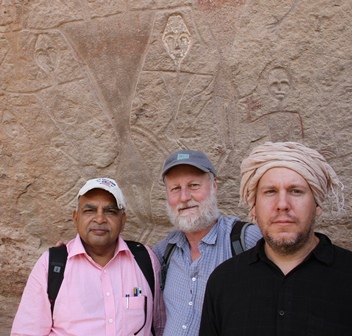Little known Chinese rock art sites similar to Franco-Cantabrian rock paintings in Western Europe were recorded by Professor Paul Taçon and Dr Maxime Aubert (Place, Evolution and Rock Art Heritage Unit) in June 2015.
With Chinese colleagues, Professors Tang Huisheng (Hebei Normal University, Shijiazhuang) and Wang Jianxin (Northwest University, Xian), they researched 12 rock art sites in the Xinjiang Uyghur Autonomous Region.
“The paintings we recorded were reminiscent of some of the oldest rock paintings of Western Europe, tens of thousands of years old, and there was a possibility they could be of similar age,’’ Professor Taçon said.
“However, we concluded they were made much more recently, less than 5000 years ago. This shows that similar types of rock paintings were made in different parts of the world at various times and that we cannot use style alone as a determinant of age, a conclusion supported by our research in southwest China a few years ago.
While in China, Professor Taçon and Dr Aubert attended the launch of the International Centre of Rock Art Dating (ICRAD), the world’s first rock art dating research centre where they were made Visiting Professors.
They are the first foreign members of ICRAD, along with Australian rock art expert Robert Bednarik and Professor Giriraj Kumar of India. Since 2008, Professor Taçon has also been an Honorary Professor at the Yunnan Institute of Cultural Relics and Archaeology in Kunming, Yunnan Province, one of the first to be appointed from outside China.
As well as Northwest University and Hebei Normal University, Professor Taçon and Dr Aubert strengthened relationships between Griffith University and various archaeological institutes across Xinjiang and the China Academy of Rock Art.
They have also recently returned from a trip to Sulawesi where they began discussions about new collaborations with Indonesian colleagues, including some from Hasanudin University.
Sulawesi has the world’s oldest rock paintings, dated to almost 40,000 years ago by Dr Aubert and his team and published in Nature last October.
Griffith and Hasannudin Universities have had an MOU since 2012.
“The June China and Indonesia trips are part of a long-term PERAHU and Griffith strategy to be increasingly research engaged with our northern neighbours during the Asian Century,’’ Professor Taçon said.

